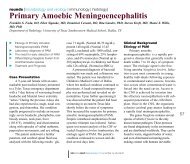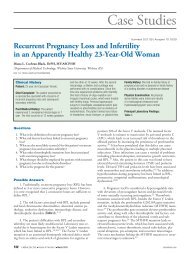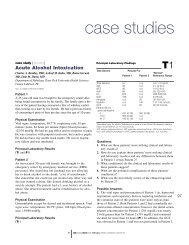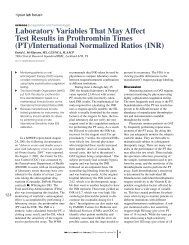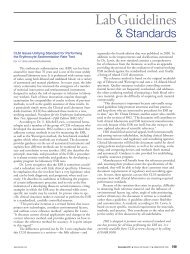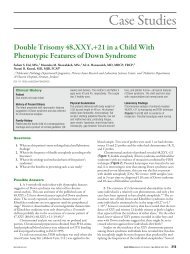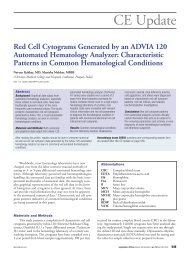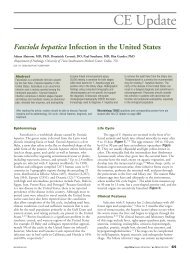Acquired Partial Lipodystrophy Associated With ... - LabMedicine
Acquired Partial Lipodystrophy Associated With ... - LabMedicine
Acquired Partial Lipodystrophy Associated With ... - LabMedicine
Create successful ePaper yourself
Turn your PDF publications into a flip-book with our unique Google optimized e-Paper software.
<strong>Acquired</strong> <strong>Partial</strong> <strong>Lipodystrophy</strong> <strong>Associated</strong><br />
<strong>With</strong> Hypocomplementemia<br />
Ceyhun Dizdarer, MD, Sema Kalkan, MD, Tugrul Ozcan, MD, Demet Tumay, MD, Safiye Aktas, MD<br />
(Dr. Behçet Uz Training and Research Children’s Hopital, Izmir, Turkey)<br />
DOI: 10.1309/0YU3XDV37GAB08KH<br />
� <strong>Acquired</strong> partial lipodystrophy is a rare<br />
condition with onset in childhood or<br />
adolescence. It is characterized by<br />
progressive loss of subcutaneous fat of the<br />
face, neck, trunk, and upper extremities in<br />
a cephalocaudal fashion and usually is<br />
coupled with C 3 hypocomplementemia.<br />
The lipodystrophy syndromes are a heterogeneous group of<br />
syndromes characterized by selective loss of fat from various parts<br />
of the body. 1 They are classified into 2 major types: familial and<br />
acquired. The main subtypes of familial lipodystrophies are congenital<br />
generalized lipodystrophy, an autosomal recessive disorder<br />
characterized by near complete lack of metabolically active adipose<br />
tissue from birth, and familial partial lipodystrophy, Dunnigan<br />
type, an autosomal dominant disorder characterized by loss of<br />
subcutaneous fat from the extremities at puberty and excess fat<br />
accumulation in the face and neck. Patients with acquired generalized<br />
lipodystrophy have generalized loss of subcutaneous fat, but<br />
those with acquired partial lipodystrophy have fat loss limited to<br />
the face, trunk, and upper extremities. 2 (Table 1)<br />
<strong>Acquired</strong> partial lipodystrophy is a rare condition with approximately<br />
250 described patients of various ethnic origins. 3<br />
This variety (like acquired generalized lipodystrophy) occurs approximately<br />
3 times more often in women, begins during childhood,<br />
and has underlying autoimmunity. 2<br />
Table 1_Classification of <strong>Lipodystrophy</strong> Syndromes<br />
Familial or Genetic Types <strong>Acquired</strong> Types<br />
1. Congenital generalized lipodystrophy 1. <strong>Acquired</strong> generalized lipodystrophy<br />
(Berardinelli-Seip Syndrome ) (Lawrence syndrome)<br />
2. Familial partial lipodystrophy 2. <strong>Acquired</strong> partial lipodystrophy<br />
a. Dunnigan variety (Barraquer–Simons syndrome)<br />
b. Köbberling variety 3. Lipodistrophy in human<br />
c. Mandibuloacral dysplasia variety immunodeficiency virus-patient<br />
3. Other types 4. Localized lipodystrophies<br />
a. Drug-induced<br />
b. Pressure-induced<br />
c. Panniculitis variety<br />
d. Centrifugal variety<br />
e. Idiopathic<br />
� Insulin resistance and its accompanying<br />
complications appear to be infrequent.<br />
Women are affected approximately 3 times<br />
more often than are men.<br />
Rounds<br />
Received 1.25.05 | Revisions Received 3.17.05 | Accepted 5.4.05<br />
� Owing to its rarity in male patients, we are<br />
presenting the case of acquired partial<br />
lipodystrophy in a 12-year-old boy with a<br />
granular accumulation of C 3 in the<br />
basement membrane on skin biopsy.<br />
Case Report<br />
A 12-year-old boy presented with a history of progressive<br />
loss of fat for the last 2 years. He was a product of a non-consanguineous<br />
marriage, born at term with a birth weight of 3 kg. His<br />
development was normal and the child was asymptomatic until<br />
10 years of age when progressive thinning of face was first noted.<br />
There was no history of fever, loss of appetite, polyuria, polydypsia,<br />
or chronic diarrhea. He had been evaluated for tuberculosis<br />
and malabsorption syndromes. There was no history of similar<br />
cases in the family. Clinical examination was unremarkable except<br />
for a marked symmetrical atrophy of fat over buccal region<br />
and temples (Images 1 and 2). His weight, height, triceps skinfold,<br />
and subscapular skinfold thickness were 35 kg, 141cm,<br />
3.37 mm, 4.37 mm, respectively. There was no hepatomegaly.<br />
Laboratory evaluation revealed normal levels of hemoglobin,<br />
serum electrolytes, blood urea, fasting and postprandial blood<br />
sugar, liver, and the thyroid function tests (Table 2). First phase<br />
insulin response (FPIR) in intravenous glucose tolerance test:<br />
(1’+3’) was 109 mU/mL with 6.93 value for K; fasting<br />
glucose/insulin ration (Go/Io) was 13.70; homeostatic model<br />
assessment (HOMA) was 1.80. The lipid profile was also normal<br />
with serum total cholesterol, high-density lipoprotein<br />
cholesterol, low-density lipoprotein cholesterol, and total triglyceride<br />
levels of 149 mg/dL, 41mg/dL, 18 mg/dL, and 90 mg/dL,<br />
respectively. The Mantoux test was negative, and urinalysis revealed<br />
no abnormality. Autoantibodies were negative. Plasma<br />
leptin level was 5 mg/mL for BMI: 20.29 kg/m². Plasma complement<br />
3 (C3 ) level was reduced to 21 mg/dL. On skin biopsy,<br />
there was a granular accumulation of C3 in the basement membrane<br />
(Image 3). A diagnosis of partial lipodystrophy was considered<br />
because of gradual onset loss of subcutaneous fat from<br />
the face, neck, trunk, and upper extremities occurring during<br />
childhood (essential criterion), low serum C3 associated with<br />
accumulation of C3 in the basement membrane, and absence of<br />
insulin resistance and metabolic complications. 2 Since the patient's<br />
main concern was the facial appearance, he was referred<br />
546 LABMEDICINE � Volume 36 Number 9 � September 2005 labmedicine.com
Image 1_Facial appearance of patient at 6<br />
years of age.<br />
to a plastic surgeon. A graft surgery was advised, which was,<br />
however, refused by the child's parents.<br />
Discussion<br />
Initially reported by Mitchell and later by Barraquer and<br />
Simons, acquired partial lipodystrophy occurs before the age of<br />
16 years, with a median age of 8 years. 2 The onset of symptoms<br />
is usually preceded by an episode of an acute viral infection. Afterwards<br />
there is a symmetrical disappearance of facial fat, extending<br />
to involve the neck, shoulders, arms, forearms, thoracic<br />
region and upper abdomen, while occasionally extending to the<br />
groin or thighs. Usually legs and hips are spared. The face is affected<br />
first, and in advanced cases, takes on a characteristic cadaverous<br />
look. Ten percent of cases may have hemilipodystrophy<br />
involving half of the face or body. 4 Whereas, the Dunnigan variety<br />
of the familial type of partial lipodystrophy, commencing at<br />
puberty is characterized by loss of subcutaneous fat only from<br />
the limbs, with maintenance of fat on face and trunk. 5<br />
It is well documented that the patients with familial lipodystrophy<br />
(partial or generalized) develop insulin-resistant diabetes<br />
mellitus, and have high triglycerides and free fatty acids levels.<br />
Their plasma leptin concentrations are generally low, consistent<br />
with absence of body fat. 6 However, patients with acquired partial<br />
lipodystrophy seldom have metabolic abnormalities associated<br />
with insulin resistance such as elevated lipid levels,<br />
acanthosis nigricans, hirsutism, or menstrual abnormalities. 7 Abnormal<br />
glucose tolerance tests and hypertriglyceridemia are inconsistently<br />
reported findings. 8 Experiments using lipoatrophic<br />
mice, developed by disruption of adipogenesis or inducing<br />
adipocyte death, have demonstrated that the metabolic disorder<br />
correlates with the amount of fat loss, suggesting that insulin<br />
resistance results from the lack of adipose tissue. 9 The lack of<br />
white adipose tissue also causes leptin deficiency, which<br />
A B<br />
Rounds<br />
Image 2 A-B_Facial appearance of patient at 12 years of age showing loss of buccal fat,<br />
neck, trunk, and upper extremities’ subcutaneous fat.<br />
Image 3_Immunofluorescence micrograph from skin biopsy demonstrating<br />
granular accumulation of C 3 along the basement membrane.<br />
contributes to the insulin resistance. On the other hand, the new<br />
classification of human white adipose tissue into metabolically<br />
active adipose tissue, which is located in the most subcutaneous<br />
areas, intraabdominal and intrathoracic regions, bone marrow,<br />
and parathyroid glands, and mechanical adipose tissue, presented<br />
in the orbits, crista galli, buccal region, tongue, palms and soles,<br />
scalp, perineum, vulva, periarticular regions, epidural area, and<br />
pericalyceal regions of the kidney might contribute to the explanation<br />
of metabolic derangements in different types of<br />
lipodystrophy syndromes. Owing to it, patients with acquired<br />
partial lipodystrophy who have well preserved metabolically<br />
labmedicine.com September 2005 � Volume 36 Number 9 � LABMEDICINE 547
Rounds<br />
Table 2_Laboratory Data of the Presented Patient<br />
Laboratory Data Value Reference Range<br />
Hemoglobin 12.0 mg/dL 11.5-15.5 mg/dL<br />
Urea Nitrogen 10 mg/dL 7-18 mg/dL<br />
Aspartate aminotransferase (AST) 30 U/L 5-45 U/L<br />
Alanine aminotransferase (ALT) 22 U/L 50-45 U/L<br />
Thyroid Stimulating Hormone (TSH) 2.9 µIU/mL 0.34-5.6 uIU/mL<br />
Free Triiodothyronine (FT3) 3.6 pg/mL 2.39-6.79 pg/mL<br />
Free Thyroxine (FT4) 0.98 ng/dL 0.58-1.64 ng/dL<br />
Total Triiodothyronine( TT3 ) 1.2 ng/mL 0.87-1.78 ng/mL<br />
Total Thyroxine (TT4) 10.2 mg/dL 6.09-12.23 mg/dL<br />
Fasting Glucose 86 mg/dL 60-100 mg/dL<br />
Postprandial Glucose 102 mg/dL 100 mU/mL<br />
K (Glucose Assimilation Coefficient) = 69/t 6.9 >1.3<br />
Fasting Glucose/Insulin Ration (Go/Io) 13.7 >6<br />
Homeostatic Model Assessment (HOMA) 1.8
Table 3_Molecular Basis of Hereditary <strong>Lipodystrophy</strong> Syndromes<br />
Familial or Genetic Types<br />
1. Congenital Generalized <strong>Lipodystrophy</strong> (Berardinelli-Seip Syndrome ) 2. Familial <strong>Partial</strong> <strong>Lipodystrophy</strong><br />
Type 1 Type 2 Other Dunnigan variety Mandibuloacral dysplasia variety<br />
Chromosome 9q34 Chromosome 11q13 ? Chromosome 1q21-22 Chromosome 1q21-22<br />
CGL1gene 2 LMNA gene 3,9 LMNA gene 3,9<br />
AGPAT2gene 3 PPAR[gamma] gene 3 ZMPSTE24 gene 3<br />
However, in a reported series of 12 patients with acquired partial<br />
lipodystrophy, 4 died of renal failure after onset of<br />
lypodystrophic changes. 13<br />
Presenting this patient, we want to emphasize once again that<br />
each lipodystrophy has not only a unique clinical picture but also<br />
an unique underlying pathogenic mechanism. Therefore, enlightening<br />
of autoimmune base in the etiopathogenesis of acquired<br />
partial lipodystrophy may also lead to the discovery of therapeutic<br />
approaches to prevent the loss of adipocytes, induce adipogenesis<br />
in lipodystrophic regions, and prevent or delay the onset of metabolic<br />
complications in patients with lipodystrophy. 14 LM<br />
1. Reitman ML, Arioglu E, Gavrilova O, et al. Lipoatrophy revisited. Trends<br />
Endocrinol Metab. 2000;11:410-416.<br />
2. Garg A. Lipodystrophies. Am J Med. 2000;108:143-152.<br />
3. Garg A. <strong>Acquired</strong> and inherited lipodystrophies. N Engl J Med.<br />
2004;350:1220-1234.<br />
4. Kumar R, Seema A, Aneja S, et al. <strong>Partial</strong> lipodystrophy in a boy. Indian<br />
Pediatrics. 2000;37: 93-96.<br />
5. Reardon W, Temple IK, Mackinnon H, et al. <strong>Partial</strong> lipodystrophy syndromes<br />
a further male case. Clin Genet. 1990;38:391-395.<br />
Rounds<br />
6. Epstein EH. <strong>Lipodystrophy</strong>. In: Freedberg IM, Eisen AZ, Wolff K, Austin KF,<br />
Goldsmith LA, Katz SI. Fitzpatrick's Dermatology in General Medicine, New<br />
York: McGraw Hill Health Professions Division. 1999; 1:1289-1291.<br />
7. Misra A, Peethambaram A, Garg A. Clinical features and metabolic and<br />
autoimmune derangements in acquired partial lipodystrophy: Report of 35<br />
cases and review of the literature. Medicine (Baltimore). 2004;83:18-34.<br />
8. Gurbuz O, Yucelten D, Ergun T, et al. <strong>Partial</strong> lipodystrophy. Int J Dermatol.<br />
1995;34:36-37.<br />
9. Shackleton S, Lloyd DJ, Jackson SN, et al. LMNA, encoding lamin A/C, is<br />
mutated in partial lipodystrophy. Nat Genet. 2000;24:153.<br />
10. Bhayana S, Hegele RA. The molecular basis of genetic lipodystrophies. Clin<br />
Biochem. 2002;35:171-177.<br />
11. McLean RH, Hoefnagel D. <strong>Partial</strong> lipodystrophy and familial C3 deficiency.<br />
Hum Hered. 1980;30:149-154.<br />
12. Matheieson PW, Peters DK. <strong>Lipodystrophy</strong> in MCGN type II: the clue to<br />
links between the adipocyte and complement system. Nephrol Dial Transplant.<br />
1997;12:1804.<br />
13. Simpson NB, Cunliffe WJ, Davison A. <strong>Partial</strong> lipodystrophy,<br />
glomerulonephritis and hypo-complementemia. Br J Dermatol.<br />
1979;101(Suppl 17):2429-2430.<br />
14. Power DA, Ng YC, Simpson JG. Familial incidence of C3 nephritic factor,<br />
partial lipodystrophy and memebranoproliferative glomerulonephritis.Q J Med.<br />
1990;75:387-398.<br />
labmedicine.com September 2005 � Volume 36 Number 9 � LABMEDICINE 549




